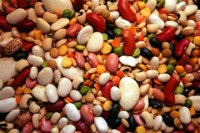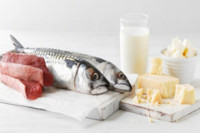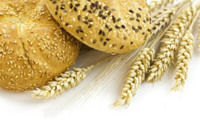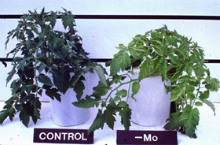- Molybdenum: effects on health and the environment
- Molybdenum is a trace mineral that provides a number of health benefits.
- Helps fight anemia
- Anemia is characterized by a lack of healthy red blood cells which are responsible for carrying oxygen to different parts of the body. Molybdenum may assist in preventing anemia by helping to mobilize iron. The iron in the body provides oxygen to organ systems.
- Helps prevent cancer
- Molybdenum plays a key role in the formation and activation of aldehyde oxidase, which helps detoxify acetaldehyde. Acetaldehyde is a toxic substance that may cause cancer, stress the liver and kidneys, and promote vitamin B deficiency.
- Prevents asthma
- Asthma is often an allergic response to chemical compounds. Chemical preservatives found in wine and some foods called sulfites may cause asthma. Adding molybdenum-containing foods or supplements may help improve asthmatic conditions, because the mineral functions as a sulfite detoxifier.
- Other potential health effects
- Molybdenum may also help prevent dental cavities, certain mouth and gum disorders, and sexual impotence in men.
 As our bodies need only small amounts of molybdenum, and we can obtain it from our diet, deficiencies in this trace mineral are rare.
As our bodies need only small amounts of molybdenum, and we can obtain it from our diet, deficiencies in this trace mineral are rare. - However, people who have a genetic condition that interferes with their absorption of molybdenum, or who receive nutrition intravenously due to a prolonged illness, may be at risk for molybdenum deficiency. People whose living environment has a low level of molybdenum may also suffer from molybdenum deficiency.
- Molybdenum deficiency symptoms
- The first symptoms of molybdenum deficiency are most often related to malfunctions of the liver, such as jaundice, nausea, and fatigue.
- Sometimes moderate molybdenum deficiency can result in sulfite toxicity. This usually causes headaches, tachypnea, tachycardia, vomiting, nausea and coma.
- The symptoms of severe molybdenum deficiency may include seizures, lens dislocation, retardation and opisthotonus.
- Where can molybdenum be obtained?
- Molybdenum is a trace element that is essential for our health and we can obtain it from foods. There are several good dietary sources of molybdenum.
- •Nuts and seeds
 Nuts of all kinds are an excellent source of molybdenum, for instance walnuts (7.38 mg of the mineral per quarter cup) and almonds (10.18 mcg in a quarter cup). Sunflower seeds and cashew nuts are also good sources.
Nuts of all kinds are an excellent source of molybdenum, for instance walnuts (7.38 mg of the mineral per quarter cup) and almonds (10.18 mcg in a quarter cup). Sunflower seeds and cashew nuts are also good sources.- •Legumes
 Legumes, which include lentils and beans, are another excellent source of dietary molybdenum. In general, vegetables that grow above the ground are a better source of molybdenum than tubers or root vegetables. Beans that have a high level of molybdenum include lima beans (141 mcg per cup), kidney beans (132.75 mcg per cup), black beans (129 mcg per cup), garbanzo beans/chickpeas (123 mcg per cup). Navy beans, pinto beans and green peas are also excellent sources of molybdenum.
Legumes, which include lentils and beans, are another excellent source of dietary molybdenum. In general, vegetables that grow above the ground are a better source of molybdenum than tubers or root vegetables. Beans that have a high level of molybdenum include lima beans (141 mcg per cup), kidney beans (132.75 mcg per cup), black beans (129 mcg per cup), garbanzo beans/chickpeas (123 mcg per cup). Navy beans, pinto beans and green peas are also excellent sources of molybdenum.- •Meat, fish and dairy
 Molybdenum can also be found in animal products. Health Food Benefits recommends milk, pork and lamb's liver as good molybdenum sources. Beef liver is also rich in molybdenum. The contributions of dairy products are more modest, for example, the molybdenum in a cup of low-fat yogurt is 11.27 mcg.
Molybdenum can also be found in animal products. Health Food Benefits recommends milk, pork and lamb's liver as good molybdenum sources. Beef liver is also rich in molybdenum. The contributions of dairy products are more modest, for example, the molybdenum in a cup of low-fat yogurt is 11.27 mcg.- •Grains
 We can also obtain molybdenum by eating grains. Brown rice, barley, oats, whole wheat and corn are good sources, with wheat germ scoring the highest at 100 mcg per 3 oz. serving.
We can also obtain molybdenum by eating grains. Brown rice, barley, oats, whole wheat and corn are good sources, with wheat germ scoring the highest at 100 mcg per 3 oz. serving.- The recommended dietary allowance for molybdenum:

- The general public may be exposed to small amounts of molybdenum in the air or by eating food or drinking water. Occupational exposure may occur through inhalation and skin contact at workplaces where molybdenum or molybdenum goods are produced or used.
- The health effects of molybdenum exposure
- Inhalation of molybdenum fumes and dust may cause irritation of the eyes, the mucous membranes and the skin.
- People may develop hyperuricemia or gout-like symptoms after long-term exposure, such as joint pains in the knees, hands, feet, articular deformities, erythema, and edema of the joint areas.
- Animal experiments show that molybdenum exposure may also cause toxicity, kidney disease, chronic respiratory disease and liver disease.
- How to reduce the risks of molybdenum exposure
- Don't eat food or drink water that was contaminated by molybdenum, and don't eat, drink or smoke where molybdenum is refined or processed.
- Post hazard and warning information on molybdenum in the workplace and communicate with potentially exposed workers about information on its health and safety effects.
- Wear protective work clothing. If clothes are contaminated by molybdenum, workers should change them and wash thoroughly at the end of the work shift before they go home.
- Molybdenum is a ubiquitous element in the environment, and occurs in soil, water, plants and animals to the extent of a few parts per million. It is recognized as an essential trace metal for virtually all organisms in view of its functional role as an active cofactor in various bacterial, plant, and animal enzymes.
 Molybdenum is less soluble in acid soils and more soluble in alkaline soils. Molybdenum in acid soils tends to be unavailable to plants. This is why most molybdenum deficiencies occur on acid, rather than on neutral or alkaline soils. A remedy is to add lime to the soil to reduce its acidity, making molybdenum in the soil available for plant uptake.
Molybdenum is less soluble in acid soils and more soluble in alkaline soils. Molybdenum in acid soils tends to be unavailable to plants. This is why most molybdenum deficiencies occur on acid, rather than on neutral or alkaline soils. A remedy is to add lime to the soil to reduce its acidity, making molybdenum in the soil available for plant uptake. - As with other trace metals, though, what is essential in tiny amounts can be highly toxic at larger doses. Animal experiments have shown that a high level of molybdenum may cause fetal deformities. Fodder with more than 10 ppm of molybdenum would put most livestock at risk.
-
About us
Contact us
Make a suggestion
- Metalpedia is a non-profit website, aiming to broaden metal knowledge and provide extensive reference database to users. It provides users reliable information and knowledge to the greatest extent. If there is any copyright violation, please notify us through our contact details to delete such infringement content promptly.
 As our bodies need only small amounts of molybdenum, and we can obtain it from our diet, deficiencies in this trace mineral are rare.
As our bodies need only small amounts of molybdenum, and we can obtain it from our diet, deficiencies in this trace mineral are rare.  Nuts of all kinds are an excellent source of molybdenum, for instance walnuts (7.38 mg of the mineral per quarter cup) and almonds (10.18 mcg in a quarter cup). Sunflower seeds and cashew nuts are also good sources.
Nuts of all kinds are an excellent source of molybdenum, for instance walnuts (7.38 mg of the mineral per quarter cup) and almonds (10.18 mcg in a quarter cup). Sunflower seeds and cashew nuts are also good sources. Legumes, which include lentils and beans, are another excellent source of dietary molybdenum. In general, vegetables that grow above the ground are a better source of molybdenum than tubers or root vegetables. Beans that have a high level of molybdenum include lima beans (141 mcg per cup), kidney beans (132.75 mcg per cup), black beans (129 mcg per cup), garbanzo beans/chickpeas (123 mcg per cup). Navy beans, pinto beans and green peas are also excellent sources of molybdenum.
Legumes, which include lentils and beans, are another excellent source of dietary molybdenum. In general, vegetables that grow above the ground are a better source of molybdenum than tubers or root vegetables. Beans that have a high level of molybdenum include lima beans (141 mcg per cup), kidney beans (132.75 mcg per cup), black beans (129 mcg per cup), garbanzo beans/chickpeas (123 mcg per cup). Navy beans, pinto beans and green peas are also excellent sources of molybdenum. Molybdenum can also be found in animal products. Health Food Benefits recommends milk, pork and lamb's liver as good molybdenum sources. Beef liver is also rich in molybdenum. The contributions of dairy products are more modest, for example, the molybdenum in a cup of low-fat yogurt is 11.27 mcg.
Molybdenum can also be found in animal products. Health Food Benefits recommends milk, pork and lamb's liver as good molybdenum sources. Beef liver is also rich in molybdenum. The contributions of dairy products are more modest, for example, the molybdenum in a cup of low-fat yogurt is 11.27 mcg. We can also obtain molybdenum by eating grains. Brown rice, barley, oats, whole wheat and corn are good sources, with wheat germ scoring the highest at 100 mcg per 3 oz. serving.
We can also obtain molybdenum by eating grains. Brown rice, barley, oats, whole wheat and corn are good sources, with wheat germ scoring the highest at 100 mcg per 3 oz. serving.
 Molybdenum is less soluble in acid soils and more soluble in alkaline soils. Molybdenum in acid soils tends to be unavailable to plants. This is why most molybdenum deficiencies occur on acid, rather than on neutral or alkaline soils. A remedy is to add lime to the soil to reduce its acidity, making molybdenum in the soil available for plant uptake.
Molybdenum is less soluble in acid soils and more soluble in alkaline soils. Molybdenum in acid soils tends to be unavailable to plants. This is why most molybdenum deficiencies occur on acid, rather than on neutral or alkaline soils. A remedy is to add lime to the soil to reduce its acidity, making molybdenum in the soil available for plant uptake. 